


|

|
Get on our mailing list and make a difference. We
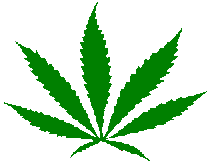


MARIJUANA
AN
THE
UNTOL
The purpose of this article (a 20-minute read) is to expose the numerous facts about marijuana and hemp that have been suppressed--facts the government does not want you to know.
You are encouraged to copy and distribute this document freely assuming this work remains unaltered and is distributed free of charge.
Author: Thomas J. Bouril, 1997
Portions copyright 1997 Cannabis Action Network and CANNABIS.COM
Hemp is a plant that
can be used to produce thousands of products. Hemp is of the same plant
species that produces marijuana; its scientific name is Cannabis Sativa. Hemp has been used
for thousands of years to produce products like paper, textiles, oil, rope, and
canvas. In fact, the word canvas is derived from the word cannabis. Hemp grown for industrial
use is very low in THC (the psychoactive chemical in marijuana), thus making
industrial hemp useless as a drug. Although marijuana is most commonly
known as a recreational drug, marijuana also has many medicinal
uses.
HEMP: THE
WORL
AMAZING FACTS
ABOUT AN AMAZING PLANT
·
On an annual basis, 1 acre of
hemp will produce as much fiber as 2 to 3 acres of cotton. Hemp fiber
is stronger and softer than cotton, lasts twice as long as cotton, and
will not mildew. Many textile products (shirts, jackets, pants, backpacks,
etc.) made from 100% hemp are now available.
·
Cotton grows only in moderate
climates and requires more water than hemp; but hemp is frost tolerant,
requires only moderate amounts of water, and grows in all 50 states.
Cotton requires large quantities of pesticides and herbicides—50% of the world’s
pesticides/herbicides are used on cotton. But hemp requires no
pesticides, no herbicides, and only moderate amounts of
fertilizer.
·
On an annual basis, 1 acre of
hemp will produce as much paper as 2 to 4 acres of trees. From tissue
paper to cardboard, all types of paper products can be produced from hemp.
Global demand for paper will double within 25 years. Unless tree-free
sources of paper are developed, there is no way to meet future paper demand
without causing massive deforestation and environmental damage.
Cannabis Hemp is the world’s most promising source of tree-free
paper.
·
The quality of hemp paper is
superior to tree-based paper. Hemp paper will last
hundreds of years without degrading, can be recycled many more times than
tree-based paper, and requires less toxic chemicals in the manufacturing process
than does paper made from trees.
·
Cannabis Hemp can be used to produce
fiberboard that is stronger than wood, lighter than wood, and
fire retardant. Substituting hemp fiberboard for timber would
further reduce the need to cut down our forests. Hemp can also be used to
produce strong, durable and environmentally-friendly plastic substitutes.
Thousands of products made from petroleum-based plastics can be produced from
hemp-based composites. Mercedes Benz of
·
It takes years for trees to grow
until they can be harvested for paper or wood, but hemp is ready for
harvesting only 120 days after it is planted. Hemp can grow on most
land suitable for farming, but forests and tree farms require large tracts of
land available in few locations. Harvesting hemp rather than trees would
also eliminate erosion due to logging, thereby reducing topsoil loss and water
pollution caused by soil runoff.
·
Hemp seed oil contains a protein
that is as nutritious and more economical to produce than soybean
protein. Hemp seeds are not
intoxicating. Hemp seed oil/protein can be used to produce virtually any
product made from soybean: tofu, veggie burgers, butter, cheese, salad oils, ice
cream, milk, etc. Hemp seed can also be ground into a nutritious flour
that can be used to produce baked goods such as pasta, cookies, and
breads.
·
Hemp seed oil can be used to produce
non-toxic diesel fuel, paint, varnish, detergent, ink and lubricating
oil. Because hemp seeds account
for up to half the weight of a mature hemp plant, hemp seed is a viable source
for these products.
·
Just as corn can be converted into
clean-burning ethanol fuel, so can hemp. Because hemp produces more
biomass than any plant species (including corn) that can grow in a wide range of
climates and locations, hemp has great potential to become a major source of
ethanol fuel.
·
Literally millions of wild hemp
plants currently grow throughout the
·
From 1776 to 1937, hemp was a major
American crop and textiles made from hemp were common. Yet, The American
Textile Museum, The Smithsonian Institute, and most American history books
contain no mention of hemp. The government’s War on Marijuana Smokers has
created an atmosphere of self censorship—speaking of hemp in a positive manner
is considered taboo.
·
·
No other natural resource offers the
potential of hemp. Cannabis Hemp is capable of
producing significant quantities of paper, textiles, building materials, food,
medicine, paint, detergent, varnish, oil, ink, and fuel. Unlike other
crops, Cannabis Hemp can grow in most climates and on most farmland throughout
the world, with moderate water and fertilizer requirements, no
pesticides, and no herbicides. Cannabis Hemp (also known as
Indian Hemp) has enormous potential to become a major natural resource that can
benefit both the economy and the environment.
·
“Make the most
you can of the Indian Hemp seed and sow it
everywhere.”
—President George Washington, 1794
Hemp For
Victory
Fibers needed to make
rope, textiles and other materials were in such short supply during World War
II, the U.S. government temporarily re-legalized hemp cultivation so American
farmers could grow it for the war effort. Although the government allowed
more than 350,000 acres (550 square miles) of hemp to be cultivated during World
War II, the

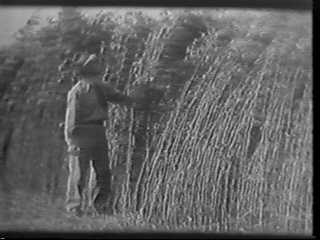
Left: Introduction to the
Right: A farmer inspects his
8-foot-tall hemp crop, which is nearly ready to
harvest.
The surrounding images
are from the 1942 U.S.


Left: A Marijuana Tax Stamp
permitted American farmers to grow hemp during World War
II.
Right: A
RE-LEGALIZE
MARIJUANA?
Many prohibitionists
discredit the need for a hemp industry because they fear hemp is being
used as a vehicle to re-legalize marijuana. The facts must be judged on
their own merit. The economic and environmental benefits of hemp are very
real. There are literally thousands of American farmers who want to grow
industrial hemp. The repeal of Hemp Prohibition is also advocated by
numerous major farm organizations, including the conservative 4.5-million-member
American Farm Bureau. Many businesses are now producing hemp-based
products and some large American corporations (International Paper, Inc.) are
beginning to advocate the repeal of Hemp
Prohibition.
It is entirely possible
to repeal Hemp Prohibition without re-legalizing marijuana because Cannabis Hemp
grown for industrial use has no drug properties.
MARIJUANA AS
ME
The
"The evidence
in this record clearly shows that marijuana has been accepted as capable of
relieving the distress of great numbers of very ill people, and doing so with
safety under medical supervision. It would be unreasonable,
arbitrary and capricious for the
"Marijuana, in
its natural form, is one of the safest therapeutically active substances
known. In strict medical terms, marijuana is safer than many
foods we commonly consume." Judge Young recommended that
the
Although the federal
government claims marijuana has no appropriate medicinal use, the federal
government contradicts itself by supplying government-grown, F
MARIJUANA /
HEMP WAS LEGAL, WHY WAS IT
BANNE
For the first 162 years
of
Shortly before
marijuana was banned by The Marijuana Tax Act of 1937, new technologies were
developed that made hemp a potential competitor with the newly-founded synthetic
fiber and plastics industries. Hemp’s potential for producing paper also
posed a threat to the timber industry (see New Billion-
After Alcohol
Prohibition ended in 1933, funding for the Federal Bureau of Narcotics (now the
Before the government
began promoting reefer madness
hysteria during the 1930s, the word marijuana was a Mexican word that was
totally absent from the American vocabulary. In the 1930s, Americans knew
that hemp was a common, useful, and harmless crop. It is extremely
unlikely anyone would have believed hemp was dangerous, or would have believed
stories of hemp madness.
Thus, the words marijuana and
reefer were substituted for the
word hemp in order to frighten
the public into supporting Hemp Prohibition. Very few people realized that
marijuana and hemp came from the same plant species; thus, virtually nobody knew
that Marijuana Prohibition would destroy the hemp
industry.
Bolstering the theory
that marijuana was banned to destroy the hemp industry, two articles were
written on the eve of Marijuana Prohibition that claim hemp was on the verge of
becoming a super crop. These articles appeared in two well-respected
magazines that are still published today. The articles are: Flax
and Hemp: From the Seed to the Loom (Mechanical Engineering,
Feb. 1937) and New Billion-
This was the first time
that billion dollar was used to
describe the value of a crop. These articles praise the usefulness and
potential of hemp by stating “hemp can be used to produce more than
25,000 products” and “hemp will prove, for both farmer and
public, the most profitable and desirable crop that can be grown.” Hemp Prohibition took effect within
one year after both these articles were written.
New
Billion-
From:
Popular Mechanics Magazine, February 1938
New Billion-
![]()
American farmers
are promised a new cash crop with an annual value of several hundred million
dollars, all because a machine has been invented that solves a problem more than
6,000 years old.
It is
hemp, a crop that will not compete with
other American products. Instead, it will displace imports of raw material
and manufactured products produced by underpaid coolie and peasant labor and
it will provide thousands of jobs for
American workers throughout the land.
The machine that makes this possible
is designed for removing the fiber-bearing cortex from the rest of the stalk,
making hemp fiber available for use without prohibitive amounts of human
labor.

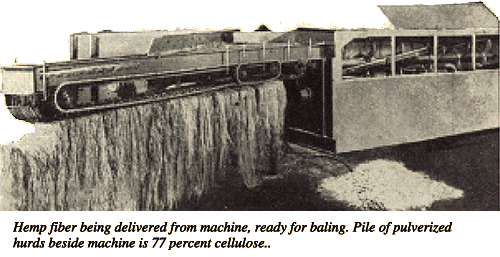
Hemp
is the standard fiber of the world. It has great tensile strength and
durability. It is used to produce more than 5,000 textile
products, ranging from rope to fine laces,
and the woody "hurds" remaining after the fiber has been removed contain more
than 77 percent cellulose, which can be used
to produce more than 25,000 products, ranging from dynamite to
Cellophane.
Machines now in service
in
From the farmer's point
of view, hemp is an easy crop to
grow and will yield from three to six tons per acre on any land that
will grow corn, wheat, or oats. It can be
grown in any state of the Union. It has a short growing season, so that it
can be planted after other crops are in. The long roots penetrate and break the soil to leave
it in perfect condition for next year's crop. The dense shock
of leaves, eight to twelve feet above the ground, chokes out weeds.
Two successive crops are enough to reclaim
land that has been abandoned because of Canadian thistles or quack
grass.
From this point on,
almost anything can happen. The raw fiber can be used to produce strong
twine or rope, woven into burlap, used for carpet warp or linoleum backing, or
it may be bleached and refined, with resinous by-products of high commercial
value. It can, in fact, be used to
replace foreign fibers which now flood our
markets.
New
Billion-
From:
Popular Mechanics Magazine, February 1938
Thousands of tons of
hemp hurds are used every year by one large powder company for the manufacture
of dynamite and TNT. A large paper company, which has been paying more
than a million dollars a year in duties on foreign-made cigarette papers, now is
manufacturing these papers from American hemp grown in
It is generally believed
that all linen is produced from flax. Actually, the majority comes from
hemp--authorities estimate that more than half of our imported linen fabrics are
manufactured from hemp fiber. Another misconception is that burlap is made
from hemp. Actually, its source is usually jute, and practically all of
the burlap we use is woven from laborers in
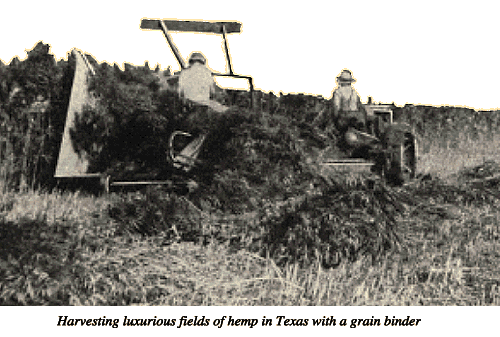
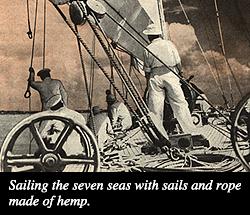
All
of these products, now imported, can be produced from home-grown
hemp. Fish nets, bow strings,
canvas, strong rope, overalls, damask tablecloths, fine linen garments, towels,
bed linen, and thousands of other everyday
items can be grown on American farms. Our imports of foreign
fabrics and fibers average about $200 million per year; in raw fibers alone we
imported over $50 million in the first six months of 1937. All of this
income can be made available for Americans.
The
paper industry offers even greater possibilities. As an
industry it amounts to over $1 billion a year, and of that, 80 percent is
imported. But hemp will produce every
grade of paper and government
figures estimate that 10,000 acres devoted to hemp will produce as much paper as
40,000 acres of average pulp land.
One obstacle in the
onward march of hemp is the reluctance of farmers to try new crops. The
problem is complicated by the need for proper equipment a reasonable distance
from the farm. The machine cannot be operated profitably unless there is
enough acreage within driving range and farmers cannot find a profitable market
unless there is machinery to handle the crop.
Another obstacle is that
the blossom of the female hemp plant contains marijuana, a narcotic, and it is
impossible to grow hemp without producing the blossom. Federal regulations
now being drawn up require registration of hemp growers, and tentative proposals
for preventing narcotic production are rather
stringent.
“…the
connection of hemp as a crop and marijuana seems to be
exaggerated.”
However, the connection of hemp as a crop and marijuana seems
to be exaggerated. The drug is usually produced from wild hemp
or locoweed, which can be found on vacant lots and along railroad tracks in
every state. If federal regulations can be drawn to protect the public
without preventing the legitimate culture of hemp, this vast new crop can add immeasurably to American
agriculture and industry.
MARIJUANA
MYTHS
Myth:
Today’s marijuana is more potent—therefore more harmful—than it was many years
ago.
Fact: There is no
medical evidence that shows high-potency marijuana is more harmful than
low-potency marijuana. Marijuana is literally one of the least
toxic substances known. High-potency marijuana may actually be
preferable to low-potency marijuana because less marijuana is consumed to
obtain the desired effect; thereby reducing the amount of smoke that enters the
lungs and lowering the risk of any respiratory health hazards. Claiming
that high-potency marijuana is more harmful than low-potency marijuana is like
claiming wine is more harmful than beer.
Myth:
Smoking marijuana can cause cancer and serious lung
damage.
Fact:
The chance of contracting cancer
from marijuana smoke is minuscule. Tobacco smokers typically smoke 20+
cigarettes every day for decades, but virtually nobody smokes marijuana in the
quantity and frequency required to cause cancer. A 1997 UCLA study (see
page 12) concluded that even prolonged and heavy marijuana smoking causes no
serious lung damage. Cancer risks from common foods (meat, salt, dairy
products) far exceed any cancer risk posed by smoking marijuana.
Respiratory health hazards and cancer risks can be totally eliminated by
ingesting marijuana via baked foods or tincture.
Myth:
Marijuana contains over 400 chemicals, thus proving that marijuana is
dangerous.
Fact:
Coffee contains 1,500 chemicals. Rat poison contains only 30
chemicals. Many vegetables contain cancer-causing chemicals. There
is no correlation between the number of chemicals a substance contains and its
toxicity. Prohibitionists often cite this misleading statistic to make
marijuana appear dangerous.
Myth:
Marijuana is a gateway drug—it leads to harder
drugs.
Fact: The
Myth:
Marijuana is addicting.
Fact:
Marijuana is not physically addicting. Medical
studies rank marijuana as less habit forming than caffeine. The
legal drugs of tobacco (nicotine) and alcohol can be as addictive as heroin or
cocaine, but marijuana is one of the least habit forming substances
known.
Myth:
Marijuana use impairs learning ability.
Fact:
A 1996
Myth:
Marijuana is a significant cause of emergency room
admissions.
Fact: The
1997:
Hemp
Prohibition
After a successful two-year trial
period of permitting experimental hemp cultivation,


These photos show an August 1997
hemp harvest in


Recently, narcotics
officers raided the house of a suspected marijuana dealer in
Prohibition is the
number one cause of
Reducing drug abuse is
a desirable goal, but law enforcement methods used to obtain that goal are
counterproductive. Prohibition costs billions to enforce, creates a black
market that generates violence and corruption, and makes criminals out of
millions of productive and harmless adults. Adult use of alcohol and
tobacco is accepted, but adult use of marijuana is considered criminal
behavior. Why?
The main
rationalization for Prohibition is to keep marijuana away from children. That
rationalization does not reflect reality. Several surveys reveal that
teenagers can obtain marijuana easier than they can obtain the legal
drugs of beer or wine. In
In 1937 (the last year
that marijuana was legal) only 100,000 Americans used marijuana. Now that
marijuana is illegal, 30 million Americans use marijuana, and marijuana is
easily available to anybody who wants it—including children and prison
inmates. 600,000 Americans are arrested for marijuana violations every
year and thousands of them are sent to jail or prison, where many of them can
still obtain drugs. The government
can’t even keep drugs out of its own prisons, yet the politicians
keep telling us they can rid the entire nation of marijuana by spending more tax
dollars. The government now spends $15 billion every year (a 1,500%
increase since 1980) waging a war on marijuana smokers—a war that has lasted 60
years and is impossible to win. Another $5 billion per year is lost
in tax revenue that could be generated if marijuana was regulated and taxed like
wine.
For all practical
purposes, Prohibition is a $15-billion-per-year government subsidy to keep
violent drug cartels, mobsters, and street dealers in business. These
violence-generating criminal enterprises prosper and flourish because the
government refuses to regulate and control drugs like marijuana. Just as
Alcohol Prohibition escalated violence and corruption during the 1920s,
Marijuana Prohibition does the same today. Who would you rather have
control the beer, wine, and liquor trade?… Al Capone and the Mafia, or
well-regulated liquor stores? Who would you rather have control the
marijuana trade?… Violent drug cartels, mobsters, and street gangs, or
well-regulated liquor stores? Prohibitionists prefer violent drug cartels,
mobsters, and street gangs.
Once all the facts are
known, it becomes clear that
THE
HEMP
INTERNET
For detailed
information on the health effects of marijuana, medical marijuana, industrial
hemp, activist
organizations,
businesses that sell hemp products, the history of marijuana and hemp, and the
government’s War on Marijuana Smokers, visit the following Web
sites.
http://www.hempbc.com
(All things marijuana/hemp related.)
http://www.cannabis.com
(Cannabis/Hemp information source.)
http://www.rxmarijuana.com
(Medical marijuana information archive.)
http://www.ecolution.com/links.html
(Links to dozens of marijuana/hemp
Web sites.)
http://www.naihc.org
(North American Industrial Hemp Council)
http://www.hempenale.com
(
http://www.ecolution.com
(100% hemp clothing and other hemp products.)
http://www.hempys.com
(100% hemp backpacks, travel bags, clothing.)
http://www.hemptech.com
(Information on industrial hemp.)
http://www.druglibrary.org
(Volumes
of information on
http://www.dpf.org
(
BOOKS
AN
The Hemp
Revolution An
excellent videotape documenting the past, present, and future of
marijuana and hemp ($20.00). Call:
1-800-649-4421
Hemp For
Victory
The
Call: 1-800-851-7039
Marijuana Myths,
Marijuana Facts Authors:
Hemp, Lifeline to
the Future
Author: Chris
Conrad
(ISBN: 0963975412)
The Great Book of
Hemp
Author: Rowan
Robinson
(ISBN: 0892815418)
ACTIVIST
ORGANIZATIONS
NORML
Phone: (202)
483-5500
Phone: (202) 462-5747
Internet:
http://www.norml.org
Internet:
http://www.mpp.org
PUBLICATIONS
Cannabis
Phone: (604)
669-9069
Phone: (707) 887-7508
Internet:
http://www.hempbc.com
Internet: http://www.hempworld.com
HEMP
PRO
Ecolution
Hempy’s
P.O. Box
Phone: (703)
207-9001
Phone: (619) 233-HEMP
Internet:
http://www.ecolution.com
Internet: http://www.hempys.com
Products: 100% hemp clothing (jeans,
jackets,
Products: 100% hemp backpacks,
shirts, shoes, hats, shorts) and
more.
travel bags, clothing, etc.
HOW
HARMFUL IS MARIJUANA?
ANNUAL AMERICAN
TOBACCO
---------------------------- 400,000
ALCOHOL
---------------------------- 100,000
ALL OTHER
LEGAL
ALL
ILLEGAL
CAFFEINE
--------------------------- 2,000
ASPIRIN
----------------------------
500
MARIJUANA
--------------------------
0
Source:
Like any substance,
marijuana can be abused. Frequent marijuana use can impede motivation, but
will not cause serious health problems. Marijuana can cause
short-term memory loss, but only
while under the influence. Marijuana does not impair
long-term memory. Marijuana does not lead to harder drugs.
Marijuana does not cause cancer, brain damage, genetic damage, nor
damage the immune system. Unlike alcohol, marijuana does not kill
brain cells or induce aggressive behavior. Long-term and heavy marijuana
smoking can cause bronchitis, but the chance of contracting bronchitis from
casual marijuana smoking is minuscule. Respiratory-related health risks
can be totally eliminated by consuming marijuana via non-smoking methods
(ingesting marijuana via baked foods, tincture, or
vaporizer).
A 1997 UCLA School of
Medicine study (Volume 155 of the American Journal of Respiratory & Critical
Care Medicine) conducted on 243 marijuana smokers over an 8-year period reported
the following: "Findings from
the long-term study of heavy, habitual marijuana smokers argue against the
concept that continuing heavy use of marijuana is a significant risk factor for
the development of chronic lung disease." "Neither the continuing nor the
intermittent marijuana smokers exhibited any significantly different rates of
decline in lung function as compared with those individuals who never smoked
marijuana.” The
long-term findings of this study clearly refute the prohibitionist argument that
marijuana smoking poses a significant danger to lung
function.
Marijuana does
not cause serious health problems like those caused by tobacco or alcohol
(i.e., strong addiction, cancer, heart problems, birth defects, emphysema, liver
damage, etc.).
CANNABIS.COM
P.O.
Phone: (610)
777-6566
http://www.cannabis.com
ÓCannabis Action
Network, 1997
This brochure is copyrighted, but it
may be reproduced and distributed without permission of The Cannabis
Action Network of Berkeley, California, under the conditions that 1) the entire contents of this brochure
remain unaltered and 2) this literary work is not sold for
profit.
Unauthorized
reproduction and distribution of this brochure is greatly
encouraged.
Get on our mailing list and make a difference. We never share your email address with anyone.